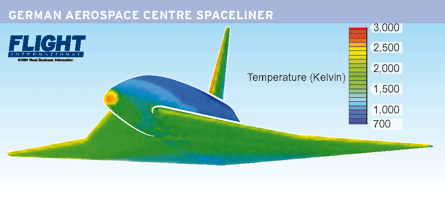Water's high vaporisation temperature makes it ideal for re-entry nosecone treatment
Transpiration cooling using water can provide thermal protection for the hot structures of hypersonic vehicles and spaceplanes, according to German researchers.
German aerospace centre DLR's Spaceliner design for a two-stage, 50-passenger suborbital vehicle for intercontinental flights was used for the research.

The rocket-powered vehicle would accelerate to 14,900mph (24,100km/h) at an altitude of less than 100km (60 miles), releasing its fly-back propellant-tank first stage and then continuing on a ballistic trajectory.
Even using a skipping re-entry trajectory to reduce the heat load, temperatures of up to 2,630ºC (4,760ºF) are expected on the wing leading edges of the second-stage vehicle, requiring new thermal protection technology.
Transpiration cooling was looked at for the nosecone, with water the fluid of choice as it has the highest heat of vaporisation of any liquid: 2,260kJ/kg at 1bar. In the experiments, 0.2g/s (0.42oz/min) of water was flowed into porous aluminium oxide/silica nosecones of up to 25mm (0.98in) radius, cooling a 25mm-radius cone from over 1,727ºC to below 227ºC. As the water flowed through the cone vaporisation encouraged capillary action to draw in more water.
"With Spaceliner you need 9t of water [for transpiration cooling]," said Martin Sippel, head of the Cologne-based DLR space launcher systems analysis group, at the final report event for the Key Technologies for Reusable Space Systems (Respace) virtual institute.
Respace also analysed gas transpiration cooling of ceramic-matrix composite (CMC) materials including carbon carbon and carbon silicon carbide and wound highly porous oxide, known as Whipox. Effective cooling was achieved with gaseous helium flow rates as low as those for water, 0.2g/s. However, questions remain over water compatibility with CMCs due tostresses from internal pressure build-up from vaporisation. Further work is required to examine wing leading-edge transpiration cooling. That research could continue under the German Research Foundation's proposed Transregio hypersonics project, involving Respace's German universities
The work will also examine rocket base-flow aerodynamics, TPS film cooling concepts and basic launcher technologies. A decision on Transregio is expected in July.
Source: Flight International























